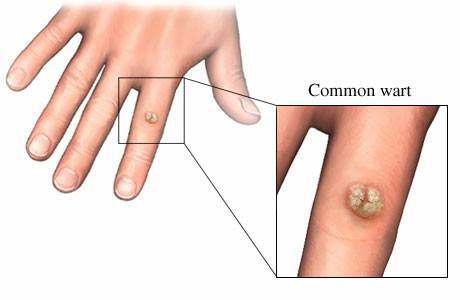Warts are growths of the skin and mucous membranes (the mouth or genitals) that are caused by over 100 types of the human papillomavirus (HPV).
Common warts are usually found on areas of the body prone to trauma, such as the elbows, knees, and hands.
The virus causes thickening of the top skin layer.
They are usually painless and go away on their own, sometimes taking a few months to resolve, but can take up to two years.
Warts are usually acquired from person-to-person contact.
The virus is not highly contagious but can cause an infection by entering through a small break in the skin.
In the same way, warts can be spread to other places on your own body.
The virus is rarely transferred by touching an object used by an infected person.
Warts can affect people of any age, but they are most common between the ages 12–16.
It is estimated that 20% of schoolchildren and about 10% of the general population have warts.
Those with HIV, organ transplants, or on chemotherapy have a higher incidence of warts due to their weakened immune system.
Signs and Symptoms
Warts may occur singly or in multiples and often have multiple small black “dots” at the surface from tiny blood vessels.
Common warts are rough, thick, skin-colored, pink, or white bumps from 1 mm to over 10 mm in size, often on the hands, face, elbows, and knees.
Filiform warts are long and narrow, like tufts of thread, and usually small at the base (1–3 mm); they often affect the face, eyelids, or nose area.
Flat warts are very slightly raised, smooth, 1–5 mm, skin-colored bumps that may appear in a line from self-inoculation from scratching or widely from shaving.
They are often seen on the face, hands, or shins.
Plantar warts are thick, rough, callus-like, often tender areas of the soles of the feet, usually on the weight-bearing areas. Since they are painful, they are often thought to be corns.
When to Seek Medical Care
Painful or bleeding warts.Warts on the face and those interfering with daily life that do not respond to self-care measures.Diabetics with warts of the feet should be treated by a physician.
Treatments Your Physician May Prescribe
Destruction with freezing (cryosurgery); burning (electrocautery); laser; or cantharidin, podophyllin, tretinoin, or acid applicationInjection of chemotherapy drugs Application of imiquimod, an immunotherapy agent, or other chemicals that induce an allergic reaction to destroy the wart
(If You Are Suffering With Any Skin Problem . We’ll Solve It In-Shaa-Allah ![]() Information/ Appointment Call On this Number 00923215667849)
Information/ Appointment Call On this Number 00923215667849)
